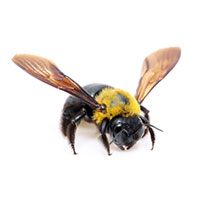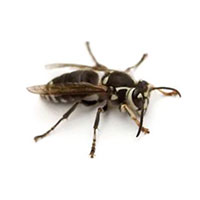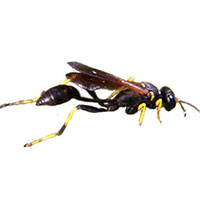Carpenter Bees in Wisconsin
Though carpenter bees, as their name would suggest, are commonly found in and around wood, the insects do not actually eat the timber. Like most bee species, carpenter bees forage on flowering plants, feeding on nectar. This is how the females collect pollen for their offspring. In contrast to the social tendencies of bumble and honey bees, carpenter bees lead solitary lives, as each female individually mates with a male to produce offspring. Mating takes place during the spring, and females then set to work cleaning out and enlarging tunnels left by earlier generations or excavate new ones in exposed, dry wood.
Carpenter Bee Habitat & Nests
Carpenter bees do not live in nests or colonies. Adult carpenter bees overwinter in abandoned nest tunnels where they have stored limited pollen to survive the colder temperatures. The bees that survive the winter will emerge in the spring to feed on nectar, mate, and build galleries. They may reuse an already existing gallery or they may excavate new galleries. Carpenter bee nests can often be found in decks, eaves, fascia boards, doors, railings, window trim, and other wooden surfaces. They prefer the wood from redwood, cedar, pine, and cypress trees and target wood that is unpainted, untreated, and weathered. However, they occasionally target painted and primed wood as well.
The tunnels they excavate into wooden surfaces are only for nurturing their eggs and young. Nests usually consist of tunnels half of an inch in diameter and 6-10″ deep and may include several brood chambers. Carpenter bees may buzz like saws when constructing nests (hence their name), but they do not eat the wood, as they cannot digest cellulose.
Carpenter Bee Behaviors & Threats
Female carpenter bees can sting in defense if provoked, but males, which may appear a bit more aggressive and territorial, cannot sting. It may be surprising to learn that this is one of the least aggressive stinging insects encountered in the summer months. Carpenter bees are considered pests because they drill holes in wooden structures; however, their contribution to pollination far outweighs any damage to structures. In general, carpenter bees do not pose much of a problem for homes and businesses, but generations of carpenter bees tunneling into the same wood can lead to significant structural damage. The carpenter bee produces broods that return to the same nest location to begin additional nests, creating trouble for those structures and homes with an infestation. Additionally, the larvae developing in homes are attractive to woodpeckers and create more extensive damage to the existing holes while creating unwanted noise.
If you have a carpenter bee problem forming in or near your property, always contact your local bee control company.
Need help with Carpenter Bees?
We'll call you! Leave your information below.





